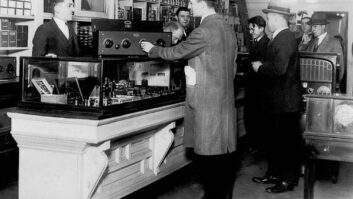Text has been updated to correct and clarify several points.
An NAB engineering session looked at two modes of interference in the FM broadcast band: one from a persnickety well-known source, the other from a new quarter altogether.
In the Broadcast Engineering Conference session “Policy Implications of Two Newly Identified Modes of Interference in the FM Broadcast Band,” engineer David Maxson detailed how some current models of radio receivers can radiate intermodulation products when they are turned off.
Maxson, owner of design, project and management company Isotrope, discovered the interference almost by happenstance. He found the anomaly while performing an equipment performance measurement test on a new FM transmitter. So like any good engineer, he trotted out an RF meter and spectrum analyzer. He was able to conclude that some broadband intermodulation products across the FM band were being emitted that could potentially impact a local radio station.
He proceeded to conduct two field tests — one in Martha’s Vineyard, another in Needham, Mass. — and found that the intermodulation was being produced by sources from within his car when the car battery was turned on.
This type of issue was brought to his attention in an article by Charlie Rhodes, a contributor to Radio World’s sister publication TV Technology, in a test conducted with a series of DTV receivers. Rhodes’ 2014 article, “Turned Off TV Sets Can Jam Signals,” revealed how intermodulation interference was being emitted from a powered-off DTV tuner.
“This is something an awful lot of electronics might do when they’re turned off,” Maxson said, whether it’s a GPS antenna or a built-in cellular communications device on an automobile. “I’m suspecting with all the technology we’re putting closer to the antenna, and when we’re powering off a tuner, there may be more susceptibility of this kind of problem than years ago when we had ceramic filters [in place],” he said.
One of the problems: This particular type of interference could easily be mistaken for receiver overload-induced blanketing interference.
“This has a potential of being a real source of trash in the spectrum,” Maxson said.
While there are many questions to ask in regard to where this is happening and what the potential causes of the interference are, there are certainly steps that can be taken.
The first is to develop best practices for consumer electronics, he said. The commission might also consider directing manufacturers to prevent the radiation of passive intermodulation in electronics that are connected to antennas. He suggested that the Federal Communications Commission consider this issue as it addresses Part 15 testing.
“You have to stress that a device connected to an antenna doesn’t create intermodulation products when it’s turned off,” he said.
The other interference issue that Maxson touched on comes from interference that arises from broadcasts of a pirate radio station.
In addition to the direct interference that a pirate can cause to potential listeners, Maxson shared details of a particular situation that literally affected the operation of a legitimate station’s HD Radio transmitter.
At a station in Boston, a first-adjacent pirate broadcast was preventing WUMB’s HD Radio transmitter from going on the air. According to Maxson, the pirate signal was conducted down the WUMB transmission line to the HD Radio adaptive precorrection sample, causing the adaptive precorrection to report a fault and keep the HD Radio transmitter from turning on.
A report on the issue made its way to the FCC Enforcement Bureau field office in Boston, which was able to take action to shut down several allegedly offending transmitters.
“This is the first time I’ve seen a pirate broadcasters actually interfere with the operation of a legitimate radio station,” Maxson said. A signal analysis showed that the illegal operator had been interfering with nearly two-thirds of the station’s legitimate listening population. “Sixty-three percent of the population that WUMB is entitled to reach was being affected in some way by one pirate,” Maxson said.
In addition to more stringent police action by the FCC, Maxson suggested that manufacturers of HD Radio transmitters might look into ways to harden systems so they are more resilient.
Making humorous use of a painting of the capture of Blackbeard — in which the pirate still appeared to have the upper hand — Maxson said: “We’re not doing very well at capturing pirate broadcasters.”
Related:












